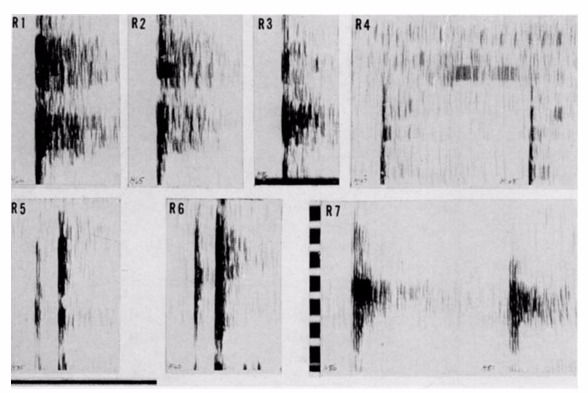What calls do redtail monkeys make? Part 2
- Margaret Bryer
- May 13, 2016
- 2 min read
In this second post, let’s look at and listen to some more vocalizations made by redtail monkeys.
All spectrograms in these posts are from Marler (1973). All audio recordings and video are my own, recorded during 2015-2016 field seasons at Kanyawara site in Kibale National Park.
HACK (Marler 1973) or POP (Cords 1987): an alarm call made by adult males. This is the most frequent alarm call I hear when following redtail monkey groups, often when eagles or chimpanzees are nearby. Marler’s and Cords’ differing terms for this vocalization started to make sense to me during my dissertation data collection: I find that this vocalization looks and sounds like “hack” when you see a male doing it fairly close up and sounds more like “pop” when you hear it from a distance.
Earlier in 2016, I observed a subgroup of chimps effectively sneak up on a group of redtail monkeys. One redtail monkey adult male, after running and hiding silently in the upper canopy until the chimps left, then came down to the ground and made over 35 hack/pop calls. I took a video of this impressive series of calls only to find later that my memory card was full and it hadn’t recorded (lesson learned: always bring more than one memory card).

Figure 3 from Marler (1973): variations of the hack (also called pop) call made by adult male redtail monkeys. R1-3 are "normal form," R4 is "abbreviated, low frequency form," R5-6 are "double forms," and R7 is "pulsed variant." R4 Kibale, others Budongo.
Scales: frequency, 500Hz; time, 0.5 seconds.
KA-TRAIN: a repetitive sequence alarm call made by adult males, considered equivalent in function by Marler to the female chirp alarm call. I heard this alarm call much less frequently than the hack/pop alarm call.

Figure 5 from Marler (1973): ka-train calls by adult male redtail monkey (by same individual) in Kibale.
Click HERE to listen to female and subadult chirps followed by (at 16 seconds in) a male ka-train when an eagle approached a redtail monkey group in 2016 in Kibale.
COUGH-GROWL: a brief call made by adult females and subadults (I am unclear on whether males make it as well) that sounds like a cross between a cough and a growl. Cords observed in Kakamega, Kenya and I've observed in Kibale that this call tends to be an initial single warning call when a predator is spotted that notifies other individuals and is followed by other individuals chirping, hack/popping and/or ka-training.
Finally, this vocalization shown in the video below is a bit of a conundrum: My and colleagues' best guess is that it is a GECKER, a submissive call made during intragroup aggression -- observed in blue monkey (Cercopithecus mitis) males as well. However, as you can see, the vocalizing male's stance does not look entirely submissive. While I'm investigating further, check out the video and let me know what you think!
References:
Cords, M. (1987). Mixed-species association of Cercopithecus monkeys in the Kakamega Forest, Kenya, by Marina Cords. University of California Publications in Zoology, 1-117.
Marler, P. (1973). A Comparison of Vocalizations of Red‐tailed Monkeys and Blue Monkeys,
Cercopithecus ascanius and C. mitis, in Uganda. Zeitschrift für Tierpsychologie, 33(3‐4), 223-247.


























Comments